Salt lakes under the south pole of Mars
Several liquid deposits of different sizes have been discovered by researchers below the south pole of Mars, according to a publication published in Nature Astronomy. The results suggest that there may be lakes below the south pole of Mars that remain liquid due to their high salt concentration.
It is known that subglacial lakes exist in the terrestrial Antarctic. Previous research has shown a similar lake below the southern Martian polar region, which was discovered by the Mars Advanced Radar for Subsurface and Ionosphere Sounding (MARSIS) on board the spacecraft Mars Express. The presence of a subglacial lake could have important consequences for astrobiology and the presence of habitable niches on Mars. However, there is a debate about whether the water depot is really liquid and how it is composed.
Elena Pettinelli and colleagues used techniques used by Earth satellites to detect Antarctic subglacial lakes to analyze MARSIS data from a 250 × 300 square kilometer area around the liquid Martian body. The authors were able to confirm the liquid nature of the previously observed lake. They also identified several other smaller water areas separated from the main body by strips of dry material.
The authors suspect that the liquid bodies are hypersaline solutions in which high concentrations of salts are dissolved in the water, which could explain why the water could remain liquid despite the cold environment at the base of the South Pole of Mars.
Of course, the extreme salinity does not sound very life-friendly, but some researchers think it is possible that life could have survived there. A recent paper written by two researchers from Harvard University and the Florida Institute of Technology (FIT) looks into this possibility.
«Extremophilic organisms are able to grow and reproduce at low temperatures below freezing,» said Avi Loeb, one of the authors of the study, in a press release. «They are found in places that are constantly cold on Earth, such as the polar regions and the deep sea, and they could also be found on the Moon or Mars».
In their work published on 20 September in The Astrophysical Journal Letters, the researchers calculate that even without the addition of salt, liquid water is possible on Mars at a depth of several kilometers. And although any life there would be exposed to the pressure of the rock above, some known unicellular organisms can survive it – this is already known from Earth.

